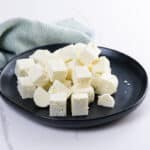How to Make Paneer at Home
Cheese-making always seems a little bit like magic to me, but once you learn how easy it is to make paneer at home, you'll never turn back. This recipe makes the perfect amount of cheese for my restaurant-style palak paneer and many other dishes. It pan-fries beautifully in a nonstick skillet.
Servings: 12 ounces (340 grams) of paneer
Ingredients
- ½ gallon 1.9 liters whole milk, not ultra-pasteurized
- 6 tablespoons (90 ml) freshly squeezed lemon juice
- 1 teaspoon fine sea salt
Instructions
- Prepare a double layer of cheesecloth and use it to line a medium strainer.
- Pour the milk into a large, heavy pot. Set over high heat.
- Cook, stirring occasionally, until just shy of boiling. It will develop a foamy, frothy layer on top and a nice aroma.
- Just as it’s threatening to break into a boil, remove from heat.
- Pour in the lemon juice and give it a stir. It should break into white curds and clear, yellow whey very quickly.
- Use a slotted spoon to transfer the curds to the cheesecloth-lined strainer. Discard the whey or save for another use.
- Rinse the curds to remove any excess lemon flavor and cool them down a bit.
- Sprinkle the salt onto the curds and stir to distribute.
- Gather the cheesecloth and squeeze out as much liquid as possible. (Stop if you start to see the curds eking through the cheesecloth.)
- Flatten curds, still in cheesecloth, into a disc on a plate. Fold excess cheesecloth on top.
- Place a second plate on top and weight with a large can.
- Transfer to refrigerator for at least two hours. Paneer will become firmer and easier to cube and fry as it presses, but you can use it in curries when it’s softer.
Notes
- Start with the best-quality whole milk you can find. I always try to use organic dairy products for the health of my family, animals, and the planet, and paneer-making is no exception. However, it's important to use milk that has not been ultra-pasteurized, since the high temperatures used in that process denature some of the proteins necessary for cheese to coagulate. In the U.S., a lot of organic milk is ultra-pasteurized, so it's important to read the label. The law requires ultra-pasteurized (UHT) milk to be labeled as such, so you'll know. Smaller local or regional brands such as the one pictured here tend to be great bets in terms of both fabulous flavor and lower likelihood of UHT.
- I like to use freshly squeezed lemon juice to separate the curds and whey, since I typically have lemons on hand, and it works easily and reliably. I call for quite a bit, since commercial milk is typically homogenized and needs a little extra help to separate. You can use less if your milk responds more quickly, adding a little bit at a time and stirring until the curds separate. You'll rinse the curds, which removes the lemon flavor. Other traditional choices include plain yogurt and vinegar. Refer to the recipe card below for more information.
- Paneer does not always contain salt, but I really prefer it. Salt brings out the flavors in the paneer itself and the resulting dish, and it also helps the cheese firm up. As per usual, I use fine sea salt, which distributes well and has a nice, clean flavor profile.
- If the curds and when do not separate right away, cover the pot and let it sit for up to 10 minutes. If still not separated, add another tablespoon of lemon juice and stir again. As a last resort, return to the heat for a moment.
- You can separate the milk's curds and whey with plain yogurt or vinegar if you prefer. Start with 1/4 cup plain yogurt or two tablespoons of a relatively neutral-tasting 4% to 5% acidity vinegar such as most common brands of distilled white or apple cider vinegar. Yogurt tends to produce a slightly softer paneer. If using vinegar, be sure to rinse the curds very well to remove any residual vinegar flavor.
- Paneer keeps well in the fridge for a week, so you can make it in advance and use it in a recipe anytime throughout the week. I like to stop pressing it after 24 hours or so and transfer to an airtight container, then dice right before using. Leftover pan-fried paneer operates on a similar timeline.
Nutrition
Serving: 1ounce | Calories: 6kcal | Carbohydrates: 1g | Cholesterol: 1mg | Sodium: 182mg | Sugar: 1g
QR code
Scan this QR code with your phone's camera to view this recipe on your mobile device.
